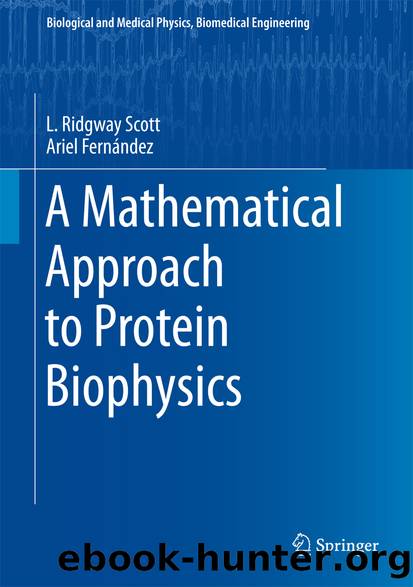A Mathematical Approach to Protein Biophysics by L. Ridgway Scott & Ariel Fernández

Author:L. Ridgway Scott & Ariel Fernández
Language: eng
Format: epub
Publisher: Springer International Publishing, Cham
hen egg-white lysozyme
133L
130
34
13
human apomyoglobin
2HBC
146
34
3
monomeric human insulin
6INS
50
30
14
human -microglobulin
1I4F
100
17
9
The experimental techniques reviewed in the previous section suggest that the density of dehydrons correlates with protein stickiness. However, the techniques are based on measuring the aggregate behavior of a large number of proteins. One might ask for more targeted experiments seeking to isolate the force of a dehydron or at least a small group of dehydrons. Such experiments were reported in [147] based on atomic force microscopy (AFM).
We will not give the details of the experimental setup, but just describe the main points. The main concept was to attach hydrophobic groups to the tip of an atomic force microscope. These were then lowered onto a surface capable of forming arrays of dehydrons. This surface was formed by a self-assembling monolayer of the molecules SH–(CH)–OH. The OH “head” groups are capable of making OH–OH hydrogen bonds, but these will be exposed to solvent and not well protected.
The data obtained by lowering a hydrophobic probe on such a monolayer are complex to interpret. However, they become easier when they are compared with a similar monolayer not containing dehydrons. In [147], the molecule SH–(CH)–Cl was chosen.
The force–displacement curve provided by the AFM has similarities for both monolayers [147]. For large displacements, there is no force, and for very small displacements, the force grows substantially as the tip is driven into the monolayer. However, in between, the characteristics are quite different.
For the OH-headed monolayer, as the displacement is decreased to the point where the hydrophobic group on the tip begins to interact with the monolayer, the force on the tip decreases, indicating a force of attraction. Near the same point of displacement, the force on the tip increases for the chlorine-headed monolayer. Thus, we see the action of the dehydronic force in attracting the hydrophobes to the dehydron-rich OH-headed layer. On the other hand, there is a resistance at the similar displacement as the hydrophobic tip begins to dehydrate the chlorine-headed monolayer. Ultimately, the force of resistance reaches a maximum, and then, the force actually decreases to a slightly negative (attractive) value as the monolayer becomes fully dehydrated. It is significant that the displacement for the force minimum is approximately the same for both monolayers, indicating that they both correspond to a fully dehydrated state.
The force–displacement curves when the tip is removed from the surface also provide important data on the dehydronic force. The force is negative for rather large displacements, indicating the delay due to the requirements of rehydration. Breaking the hydrophobic bond formed by the hydrophobic groups on the tip and the monolayer requires enough force to be accumulated to completely rehydrate the monolayer. This effect is similar to the force that is required to remove sticky tape, in which one must reintroduce air between the tape and the surface to which it was attached. For the chlorine-headed monolayer, there is little change in force as the displacement is increased by four Ångstroms from the point where the force is minimal. Once the threshold is reached, then the force returns abruptly to zero, over a distance of about one Ångstrom.
Download
This site does not store any files on its server. We only index and link to content provided by other sites. Please contact the content providers to delete copyright contents if any and email us, we'll remove relevant links or contents immediately.
| Automotive | Engineering |
| Transportation |
Whiskies Galore by Ian Buxton(41530)
Introduction to Aircraft Design (Cambridge Aerospace Series) by John P. Fielding(32888)
Small Unmanned Fixed-wing Aircraft Design by Andrew J. Keane Andras Sobester James P. Scanlan & András Sóbester & James P. Scanlan(32573)
Craft Beer for the Homebrewer by Michael Agnew(17933)
Turbulence by E. J. Noyes(7700)
The Complete Stick Figure Physics Tutorials by Allen Sarah(7141)
Kaplan MCAT General Chemistry Review by Kaplan(6595)
The Thirst by Nesbo Jo(6436)
Bad Blood by John Carreyrou(6274)
Modelling of Convective Heat and Mass Transfer in Rotating Flows by Igor V. Shevchuk(6223)
Learning SQL by Alan Beaulieu(6035)
Weapons of Math Destruction by Cathy O'Neil(5829)
Man-made Catastrophes and Risk Information Concealment by Dmitry Chernov & Didier Sornette(5647)
Digital Minimalism by Cal Newport;(5389)
Life 3.0: Being Human in the Age of Artificial Intelligence by Tegmark Max(5184)
iGen by Jean M. Twenge(5161)
Secrets of Antigravity Propulsion: Tesla, UFOs, and Classified Aerospace Technology by Ph.D. Paul A. Laviolette(4991)
Design of Trajectory Optimization Approach for Space Maneuver Vehicle Skip Entry Problems by Runqi Chai & Al Savvaris & Antonios Tsourdos & Senchun Chai(4840)
Electronic Devices & Circuits by Jacob Millman & Christos C. Halkias(4748)
